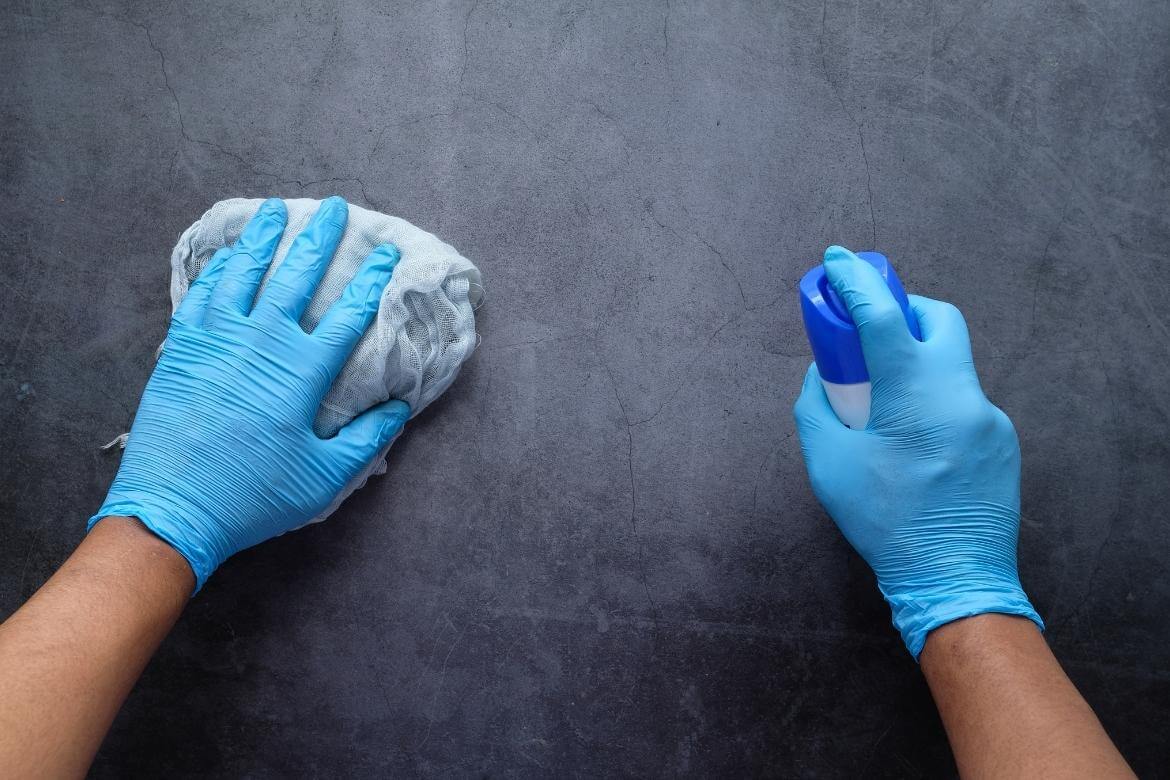4th December, 2024
COSHH Workplace Exposure Limits (WELs) Explained
WELs stands for workplace exposure limits. Under the COSHH regulations, workplace exposure limits (WELs) are assigned to around 500 hazardous substances. But what are workplace exposure limits (wels)? And how can you monitor hazardous substances to ensure WELs are not exceeded?

WELs are workplace exposure limits.
Under the COSHH regulations, workplace exposure limits (WELs) are assigned to a large number of hazardous substances that you might use at work.
And what do these WELs mean?
WELs are not a safe limit
Being below a WEL doesn't make the use of substance safe. A WEL is a maximum. You don't want to be above it, and ideally, you don't want to be near it either.

Equally, if a substance is not in the list of WELs it doesn't mean that the substance is safe. COSHH still applies, with or without a WEL, and the use of hazardous substances must be controlled for the health and safety of those using it.
With hazardous substances, your aim should always be to reduce exposure as much as you can in the circumstances.
(7) Without prejudice to the generality of paragraph (1), where there is exposure to a substance for which a maximum exposure limit has been approved, control of exposure shall, so far as the inhalation of that substance is concerned, only be treated as being adequate if the level of exposure is reduced so far as is reasonably practicable and in any case below the maximum exposure limit.
WELs are legal limits
A WEL is the legal limit for the maximum concentrations of a hazardous substance in the air.
WELs are legal limits of exposure, which means they should not be exceeded. If you allow too much of a hazardous substance into the air, you could be breaking the law.
Workplace exposure limits (WELs) come in two time periods:
- Long-term exposure limits (a limit for exposure over 8 hours)
- Short-term exposure limits (a limit for exposure over 15 minutes)
Around 500 substances have WELs assigned to them, and these hazardous substances could be chemicals, fumes, dust or fibres.

WELs are British occupational exposure limits, approved and enforced by the Health and Safety Executive. They are legally binding. You can find the full list in EH40/2005 Workplace exposure limits.
This list is legally binding, as it reproduces the list of workplace exposure limits (WELs) which have been approved by the Health and Safety Executive.
EH40/2005 Workplace exposure limits
WELs protect the health of workers
Sometimes it's not possible to eliminate exposure to a hazardous substance completely - even with controls like extraction, ventilation and PPE in place.
But some substances used at work can cause major health problems.
Substances assigned a WEL include those that are carcinogenic or mutagenic. Some could cause asthma, reproductive problems and other significant risks through high levels of inhalation.
When a substance is in the air, it might also cause irritation or injury from eye contact.
WELs help to protect the health of workers by preventing how much of a substance people come into contact with at work, and letting employers know what would be a dangerous or unacceptable level of exposure.

Some substances are harmful to health after prolonged exposure, while others can cause health problems after only brief exposures.
WELs apply to lots of substances you will have heard of like arsenic, asphalt, carbon dioxide, carbon monoxide, cement, flour dust, gypsum, hardwood dust, limestone and petroleum fumes. But also some you might not be familiar with, like piperazine dihydrochloride.
WELs time-weighted averages
Workplace exposure limits (WELs) are averaged over a specified timeframe. So within the time given (often 8 hours, but sometimes as short as 15 minutes), you are only allowed to be exposed to a certain amount of a hazardous substance.
Because the amount of a substance may fluctuate, workplace exposure limits (WELs) are subject to time-weighted averages (TWA).
The long-term exposure limit (LTEL) has an 8-hour reference period, and the short-term exposure limit (STEL) has a 15-minute reference period.
These are the two time periods used for WELs:
- Long-term (8 hours)
- Short-term (15 minutes)
Certain rules apply to these time-weighted exposures such as that the short-term exposure level takes priority over the long-term, and that the LTEL can be increased if the exposure period is less.
For substances where no short-term limit is specified, it's recommended to use three times the long-term limit as a guideline for controlling short-term peaks in exposure.
Let's look at some example calculations!

Calculating WELs
If you are responsible for monitoring WELs in your workplace, you need to be able to calculate exposure to work out if you are under the legal workplace exposure limits.
The calculation you can use is:
([time]x[exposure)/[period] = Result
For the 8-hour time-weighted average (TWA), the calculation is:
([hours]x[exposure)/8 = [8 hour TWA]
For the 15-minute time-weighted average (TWA), the calculation is:
([minutes]x[exposure)/15 = [15 minute TWA]
Simple example
A simple example of someone being exposed to 0.2mg.m-³ of a hazardous substance for 8 hours would give a time-weighted average of 0.2mg.m-³.
(8 x 0.2) / 8 = 0.2 mg.m-³
If the WEL is 1.5mg.m-³, you're nicely under the limit. But if the WEL is 0.05mg.m-³, then you are over!
But it's not that often your calculations will be this simple.
Shorter exposure calculation
It's more likely exposure will be for a shorter period while a specific task is carried out. And remember a WEL is an average. So you can calculate your levels by averaging out the exposure over the duration given.
For example, someone is exposed to 0.25mg.m-³ for 3 hours. You would calculate those 3 hours, and the remaining 5 hours at 0 to get the 8-hour time-weighted average.
((3 x 0.36) + (5 x 0)) / 8 = 0.135mg.m-³
Longer exposure calculation
The 8-hour time-weighted average is a reference period in every 24 hours in which exposure occurs.
If you work a 12-hour shift, you still must not exceed the 8-hour limit.
When calculating the exposure level, if the exposure period is longer than 8 hours then the exposure limit effectively decreases on an hourly basis.
For example, if a substance has a WEL of 10mg.m-³, exposure over 10 hours at 10mg.m-³ would be too much. Because over 10 hours would give an 8-hour TWA of 12.5mg.m-³, which is above the legal limit.
(10 x 10) / 8 = 12.5 mg.m-³
We still divide by 8 to get the 8-hour average, and you must not exceed the 8-hour WEL within any 24-hour period.
Short increased exposure calculation
Remember the 8-hour LTEL is the maximum exposure allowed over 8 hours. Averaged.
When calculating the exposure level, if the exposure period is less than 8 hours then the exposure limit can be increased providing that exposure above the LTEL value does not exceed any short-term exposure limit (STEL) and that the LTEL is not exceeded over the 8 hours.
An example is when a person is exposed to a hazardous substance with a WEL of 18mg.m-³ (8-hour TWA) for 4 hours, an adjusted exposure level of 36mg.m-³ would apply over the 4 hours. However, exposure levels above 18mg.m-³ should be restricted.
((4 x 36) + (4 x 0)) / 8 = 18mg.m-³
The exposure is 36mg.m-³ (double the limit of 18mg.m-³) but because exposure is only for 4 hours, the average over the 8-hour time frame is at the limit of 18mg.m-³.
But, remember to check the STEL!

STEL exposure calculation
The STEL (short-term exposure limit) will always take priority over the LTEL (long-term exposure limit).
- Short-term (15 minutes)
- Long-term (8 hours)
STELs apply to any 15-minute period throughout the working shift.
So if using the previous example, the substance had a STEL of 40mg.m-³, action would be required if the exposure level rose above 40mg.m-³ for more than 15 minutes.
Even though the average over the long-term exposure limit is within the WEL:
((4 x 36) + (4 x 0)) / 8 = 18mg.m-³
If during 12 minutes, the exposure is higher, exposure could be above the short-term 15-minute exposure limit:
(12 x 60) / 15 = 48mg.m-³
For substances where no short-term limit is specified, it's recommended to use three times the long-term limit as a guideline for controlling short-term peaks in exposure.
Checking exposure levels
How do you know if you are within the workplace exposure limit?
Now you know how to calculate exposure, but you will need to know how much of a substance is present in the air. You'll usually find this out through measuring and monitoring exposure.
Remember, WELs are legal limits, so you must make sure that these levels are not being exceeded.
Regulation 10 of the COSHH regulations imposes a duty to monitor the exposure of employees to substances hazardous to health in certain specified situations.

Sampling strategies may involve measurement of the hazardous substance in the breathing zone of the worker (personal sampling), or general monitoring of the workplace air.
Once you know your figures, you can calculate exposure and check you're within the limits.
To find out current workplace exposure limits (WELs) check out the HSE publication EH40 Workplace Exposure Limits, which can be downloaded from the HSE website.
Beyond WELs
Not every hazardous substance has a WEL.
If a hazardous substance is not assigned a WEL, that doesn't make it safe. It is still a hazardous substance. And the COSHH regulations still apply.
Under COSHH, you should still make sure exposure is controlled to a level which is safe for the hazardous substance used or created at work.
WELs usually apply to exposure by inhalation, as this is the main route of entry into the body for most substances. And can also be put in place where there is a risk of harm from contact with the eyes. However, the COSHH regulations apply to all routes of entry as some substances can penetrate intact skin and become absorbed into the body, and hazardous substances can harm through skin contact, contact with eyes, and injection and ingestion.
In addition to complying with WELs, it is important to also carry out a COSHH assessment and control all potential exposure routes.
Need help with COSHH? Start your COSHH register today by downloading our free template to help you identify the hazardous substances in use, and download COSHH assessment templates for your work activities.
This article was written by Emma at HASpod. Emma has over 10 years experience in health and safety and BSc (Hons) Construction Management. She is NEBOSH qualified and Tech IOSH.
Need to know COSHH?
Take our COSHH awareness elearning course and get your certificate today.
COSHH CourseRecent posts like this...

What Is A COSHH Assessment?
The COSHH regulations require you to do a COSHH assessment when using or creating hazardous substances. Most businesses will need them. But what is a COSHH assessment, its purpose, and what does this document need to include?
Read Post
9 Ways To Comply With COSHH
The Control of Substances Hazardous to Health (COSHH) Regulations apply to every workplace. Here are nine ways you can comply with COSHH - including identifying hazardous substances, assessing the substances you use and produce in your workplace, controlling the risks, keeping records, and providing training.
Read Post
Where Does COSHH Apply?
COSHH is a law that requires employers to control substances that are hazardous to health. Most businesses use substances that are hazardous to health, from cleaning chemicals to creating gases, dust and vapours - so the COSHH regulations will apply to some aspects of most businesses.
Read Post